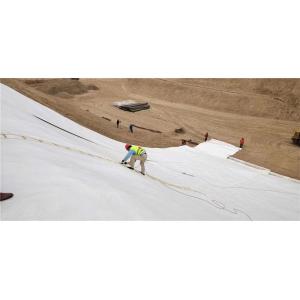Good Performance Ce Certification Agriculture Nonwoven Geotextile
Product Description:
1)short fiber needle punched nonwoven geotextile fabric is made of polypropylene or polyester.
Its production process include fluffing,comb,mix,laying then needle punched.
2)Specification:
100GSM - 1500GSM
3)Raw Material: PP or Polyester
4)Properties:
Good flexibility, permeability, filtration, separation and easy for construction
5)Usage:
Nonwoven geotextile used in the area of highway, railway, dam,filtration of reinforcement for land ,
separation,drainage and protection.
6)Size of Package:
width 2-8m,length 50-100m (or at request).
7)Regular sizes for export:
100g/M2,150g/M2,200g/M2,250g/M2,300g/M2,350g/M2,400g/M2,450g/M2,500g/M2,600g/M2, 800g/M2,1000g/M2,
4m*50M Per Roll & 4M*100M Per Roll,or as required.
8)Delivery time:within 10-20 days after receiving the advance payment
9)Small pieces of Sample is available
Product Paraments:
| Staple fiber needle punched non-woven geotextile |
| item | Specification |
| Vertical and horizontal fracture strength(KN/M) | 3 | 5 | 8 | 10 | 15 | 20 | 25 | 30 | 40 |
| Elongation corresponding to standard breaking strength (%) | 20-100 |
| CBR Bursting strength(KN) | 0.6 | 1 | 1.4 | 1.8 | 2.5 | 3.2 | 4 | 5.5 | 7 |
| Deviation rate of weight per unit area(%) | ±5 |
| Vertical and horizontal tearing strength(KN) | 0.10 | 0.15 | 0.20 | 0.25 | 0.40 | 0.50 | 0.65 | 0.80 | 1.00 |
| Width deviation rate(%) | -0.5 |
| Thickness deviation rate(%) | ±10 |
| Vertical permeability coefficient(cm/s) | k*(0.001-0.1) Ps: k=1.0-9.9 |
| Acid and alkali resistance(% ≥) | 80 |
| Antioxidant performance(% ≥) | 80 |
| UV resistance (% ≥) | 80 |
Application:
1. Stabilization In stabilization, the fabric is applied on top of a material that is highly compressible. Most often, this material is wet, soft soil. Here, the geotextile allows water to seep from the soft soil to draining material. As a result, it consolidates the basement layer, thus strengthening it and making it a more trustworthy base.
2. Separation Fabric is laid between two layers of different materials, such as two different soil types, new construction, and soil, or new and old pavement. Separation is sometimes used interchangeably with stabilization, but there are fine distinctions.
3. Filtration Using geotextile infiltration is similar to using in stabilization. The main aim in both cases is to allow the passage of water from the covered layer. The goal of this application is to remove water while preventing soil and or any other fine particles from passing through. This is achieved in combination with a filter behind the geotextile. In this process, water is removed, rather than being filtered into a different material.
4. Moisture Barrier This application is almost the direct opposite of the above applications. In the moisture barrier, the geotextile is used to block water rather than allowing water to pass through. This is accomplished by applying an asphaltic suspension. As a result, the fabric becomes impermeable and suitable for use in construction projects such as pavement rehabilitation.
5. Drainage Geotextile material can help gather water or gas and then transport it along its plane, therefore providing seamless transmission. This process is what is traditionally called drainage function, which can be highly effective in chimney drains as well as drip drains.
6. Reinforcement In reinforcement, the geotextile acts as a source of strength instead of strengthening the bottom layer like in stabilization.

